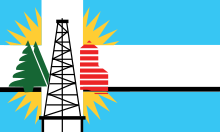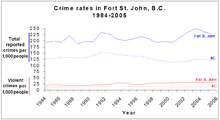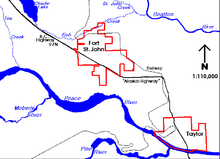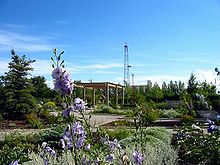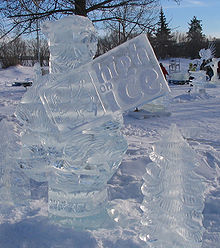- Fort St. John, British Columbia
-
City of Fort St. John 
Flag
Coat of armsNickname(s): The Energetic City Location of Fort St. John in British Columbia Coordinates: 56°15′9″N 120°50′47″W / 56.2525°N 120.84639°W Country  Canada
CanadaProvince  British Columbia
British ColumbiaRegional District Peace River Incorporated 31 Dec 1947 (village) Government – Mayor Lori Ackerman – Governing Body Fort St. John City Council – MLA Pat Pimm, Liberal – MP Bob Zimmer, Conservative party of Canada Area – City 22.74 km2 (8.8 sq mi) Elevation 690 m (2,264 ft) Population (2011) – City 22,974 – Metro 81,000 Time zone Mountain Time Zone (UTC−7) – Summer (DST) (uses Mountain Standard Time all year long) (UTC−7) Postal code span V1J Area code(s) +1-250 Website City of Fort St. John website The City of Fort St. John is a city in northeastern British Columbia, Canada. A member municipality of the Peace River Regional District, the city covers an area of about 22 km² (8 mi²) with 22,000 residents (2011 census).[1] Located at Mile 47, it is one of the largest cities along the Alaska Highway. Originally established in 1794, as a trading post, Fort St. John is the oldest European-established settlement in present-day British Columbia. Fort St. John is served by the Fort St. John Airport. The municipal slogan is, Fort St. John: The Energetic City.
Contents
History
Over the years the community has been moved a number of times for varying economic reasons. The present location is thought to be its sixth. The original trading post built in the area was named Rocky Mountain House (not to be confused with the modern Alberta city by that name). It was established one year after Sir Alexander Mackenzie explored the area in 1793. One of a series of forts along the Peace River constructed to service the fur trade, it was located southwest of the present site of Fort St. John. The Dunneza and Sikanni First Nations used it as a trading post. It was also used as a supply depot for further expeditions into the territory. The fort closed in 1805. Fort d'Epinette was built in 1806 by the North West Company. It was renamed Fort St. John in 1821 following the purchase of the North West Company by the Hudson's Bay Company. This fort was located about 500 metres downstream from the mouth of the Beatton River, which at that time was known as the Pine River (d'epinette in French). It was shut down in 1823.
After a lapse of nearly forty years, Fort St. John was reopened in 1860 on the south side of the Peace River, directly south of the present community. It was moved in 1872 by Francis Work Beatton directly across the river. This community lasted until 1925 when the river ceased to be the main avenue of transportation and the fort was moved closer to where settlers were establishing homesteads. The new town was constructed at Fish Creek, northwest of the present community, on the new trail to Fort Nelson. It did not shut down until 1975. In 1928, C. M. Finch moved his general store to two quarters of land where he also built a government building to house the land, telegraph and post offices. The present site for the town was firmly established after he donated five acres (20,000 m²) for a Roman Catholic Church and additional land for a hospital.
Demographics
The first census to include Fort St. John as a defined subdivision occurred in 1951 and recorded 884 people. The population rapidly increased, doubling almost every 5 years for 15 years so that by 1966 there were 6,749 residents living in the community.[5] Population growth slowed in the 1970s, rising by 1,551 people, from 8,264 in 1971 to 9,815 in 1978. However, by 1981 the population had swelled to 14,337 people, an increase of 4,522 people in just 3 years. A recession in the 1980s kept the population from reaching 15,000 until 1994. However, Fort St. John has managed to become the largest city in the BC Peace, and second largest after Grande Prairie in the entire Peace region, which straddles the boundary between the provinces of BC and Alberta. Since then, the population has continued to rise steadily at about 2% a year.
Canada 2001 Census[6] Fort St. John British Columbia Median age 29.6 years 38.4 years Under 15 years old 23% 18% Between 25 and 44 years old 36% 30% Over 65 years old 6% 14% Visible minority 3% 21% Protestant 38% 31% The latest census, taken in 2001, recorded 16,034 residents living in 6,155 households and 4,240 families. This was 7% more people than the previous census five years earlier. As seen by the median age almost ten years younger than the provincial median and less than half the proportion of the population over 65 years old, the city has a young population. Of those over 15 years of age in 2001, 45% were married, higher than the 51% provincial average. With 94% of Fort St. John residents being Canadian-born, and 93% with an English-only mother tongue, the town has few visible minorities. Though not included as visible minorities 11% identified themselves as Aboriginal, a higher proportion than the 4% provincial average.
Police protection is contracted to the Royal Canadian Mounted Police which operates a 26 officer municipal detachment and a 10 member rural detachment from the city.[8] In 2005, the municipal detachment reported 4,048 Criminal Code of Canada offenses, which translates into a crime rate of 228 Criminal Code offenses per 1,000 people, much higher than the provincial average of 125 offenses. During that year, compared to the provincial average, the RCMP reported much higher crime rates in Fort St. John for cocaine, cannabis, non-sexual assaults, property damage, and arson related offences. However, the city had lower crime rates for robbery, theft from motor vehicles, and business break-and-enters.[7]
Geography and climate
Fort St. John, located on the upland prairies north of the Peace River, experiences a cold subarctic climate (almost warm enough in May and September to be a humid continental climate), encompassing frigid winters and warm summers. A predominately southwesterly wind blows through town, with wind speeds averaging around 13.7 km (8.5 mi).[9] Fort St. John uses Mountain Standard Time in the winter and in the summer, and because of its northerly latitude experiences short daylight hours in the winter and long daylight hours in the summer.
Climate data for Fort St. John Month Jan Feb Mar Apr May Jun Jul Aug Sep Oct Nov Dec Year Record high °C (°F) 11.6
(52.9)12.8
(55.0)18
(64)27.9
(82.2)31.8
(89.2)31.7
(89.1)33.3
(91.9)33.6
(92.5)30.0
(86.0)25.6
(78.1)18.3
(64.9)11.4
(52.5)33.6
(92.5)Average high °C (°F) −9.9
(14.2)−6
(21.2)0.3
(32.5)9.3
(48.7)15.7
(60.3)19.2
(66.6)21.2
(70.2)20.2
(68.4)15.1
(59.2)8.2
(46.8)−2.9
(26.8)−8
(17.6)6.9 Average low °C (°F) −18.4
(−1.1)−15
(5.0)−9.1
(15.6)−1.3
(29.7)4.1
(39.4)8.2
(46.8)10.2
(50.4)8.9
(48.0)4.6
(40.3)−0.4
(31.3)−10.4
(13.3)−16.2
(2.8)−2.9 Record low °C (°F) −47.2
(−53.0)−42.2
(−44.0)−36.7
(−34.1)−28.9
(−20.0)−10.6
(12.9)−0.6
(30.9)0.7
(33.3)−2.9
(26.8)−12.8
(9.0)−25
(−13)−39.2
(−38.6)−44.6
(−48.3)−47.2
(−53.0)Precipitation mm (inches) 26
(1.02)21.9
(0.862)21.4
(0.843)18.8
(0.74)39.7
(1.563)71.4
(2.811)83.2
(3.276)56.9
(2.24)45.7
(1.799)25.8
(1.016)28.5
(1.122)26.5
(1.043)465.6
(18.331)Source: Environment Canada[10] Infrastructure
Fort St. John is the transportation hub of the region. The main highway, Highway 97 (Alaska Highway), built in 1942 by the United States Army, runs through the city, north to Fort Nelson, the Yukon, and Alaska. As the highway goes over the Peace River to Dawson Creek, it reduced the community's dependence on the river for transportation. Within the city the streets are laid out in a grid pattern. The main streets are the north-south 100 Street and the east-west 100 Avenue. The rail line that runs by the eastern and northern borders was extended from Chetwynd by the Pacific Great Eastern Railway with the first train arriving in 1958. The only commercial airport between Dawson Creek and Fort Nelson is the Fort St. John Airport located a few miles east of the city. The two runway airport has Air Canada Jazz and other smaller airlines such as Central Mountain Air and Swanberg Air with regularly scheduled flights and North Cariboo Air providing chartered flights. Greyhound Bus lines, which has a bus stop in the city, operates a route along the highway, north to Whitehorse (via Fort Nelson) and south to Dawson Creek.
The city's water and sewer infrastructure pumps water from the Peace River and Charlie Lake;[11] it is filtered, chlorinated and florinated before being distributed. Sewage is processed in one of two lagoons. The lagoon south of the city releases the processed effluent into the Peace River and the lagoon north of the city releases into the Beatton River. Storm sewer run with the sanitary sewers but is directed into the rivers without going through the lagoons. The city's fire department has volunteer and professional members and cover the city plus five miles (8 km) into the rural areas.
Culture, recreation and media
As the urban centre for approximately 50,000 people, much of the region's recreational and cultural facilities are located in town. Within the city, Centennial Park groups much of these facilities in a central location close to residences and businesses. This large park includes the Fort St. John North Peace Museum,[12] the North Peace Leisure Pool, the North Peace Arena (home of the Fort St. John Huskies), a separate arena for children, an 8-sheet curling rink, as well as an outdoor water park and speed skating oval. Other parks in the area include the city-maintained Fish Creek Community Forest, and about 10 km (6.2 mi) northwest of town the Beatton Provincial Park and Charlie Lake Provincial Park. In the center of town is the North Peace Cultural Centre which houses the Fort St. John Public Library, a theatre, and the Peace Gallery North art gallery.
Fort St. John hosted the BC Winter Games in 1984 and the Northern BC Winter Games in 1975, 1976, 1994, 2000, and 2007. Every August, the Great Canadian Welding Competition is held in Fort St. John, which sees welding artists fill Centennial Park creating statues on the year's given theme. In January the annual High on Ice Winter Carnival has a frozen Centennial Park filled with ice sculptors competing and other special winter-related activities occurring around town.
Fort St. John is served with several regional newspapers. The Alaska Highway News and the Dawson Creek Daily News, both part of the Glacier Media Group (previously owned by Canwest Global), are dailies available in the city. The Alaska Highway News, along with the free weekly and The Northerner, are published in town and focus more on Fort St. John news whereas the Dawson Creek Daily News is published in Dawson Creek. Local free magazine Northern Groove focuses on local music and live entertainment events in Fort St. John and area and is published every two months. The Northeast News is a free weekly community paper published on Thursday's with news coverage of communities in the Peace Region and is also online at: http://www.northeastnews.ca.
The radio stations broadcasting from Fort St. John include 98.5 Energy FM (CHRX-FM), 101.5 The Bear FM (CKNL-FM), 92.5 Sunrise FM (CIAM-FM) and 100.1 Moose FM (CKFU-FM), while 890 CJDC AM is available from Dawson Creek. Also available locally is CBYJ-FM 88.3, repeating CBC Radio One station CBYG-FM from Prince George. Fort St. John only has one terrestrial station, CBCD-TV-3 channel 9, rebroadcasting private CBC Television affiliate CJDC-TV from Dawson Creek.
Fort St. John has several community web pages with news, entertainment, sports, classifieds and community events such as www.energeticcity.ca, www.fsjnow.com, and www.northerngroove.com.
Economy and education
As the urban center for a rural and farming population of about 12,000 people and home to 18,000 people, Fort St. John is a retail, service and industrial center. The province's oil and gas industry,[13] including the provincial Oil and Gas Commission is centered in the city. Forestry has become more important to the city since the opening of an oriented strand board plant in 2005. Agriculture has been the mainstay of the economy servicing and providing a market for the upland prairies.
Economy[6] Rate Town Province Unemployment rate 9.1% 8.5% Participation rate 77.9% 65.2% Poverty rate 12.1% 17.8% Average male income $54,252 $50,191 Average female income $31,083 $35,895 The 2001 Canadian census recorded 9,985 income-earners over the age of 15 residing in Fort St. John; of these, 4,500 worked full time throughout the year. The high participation rate stems from the relatively young population, much of which was attracted by the area's high-paying oil and gas industry. Its male-female income gap is large.[6]
There are 14 public schools in the municipality, but only one secondary school, administered by School District 60 Peace River North. Northern Lights College opened a campus in 1981. The 2001 Census estimated that 10% of people in Fort St. John between 20 and 64 years old graduated from a university, less than half of the 24% provincial average and 27% did not graduate from secondary school, 7% higher than the provincial average.[6]
Government and politics
The City of Fort St. John has a council-manager form of municipal government. A six member council, along with one mayor, is elected at-large every three years. In the 19 November 2011 civic election Lori Ackerman was elected mayor, replacing the former newspaper publisher Bruce Lantz who served as mayor between 2008 and 2011. In the 2008 election Lantz had defeated one term mayor and former RCMP officer Jim Eglinski who had defeated the incumbent mayor of 15 years, Steve Thorlakson in 2005.[14] The mayor and one city councillor represent Fort St. John on the Board of Directors of the Peace River Regional District.[15] Three board of education trustees, for representation on School District 60 Peace River North, are also elected by the city.[16]
Fort St. John is situated in the Peace River North provincial electoral district and is represented by Pat Pimm in the Legislative Assembly of British Columbia. Pimm replaced long-time MLA Richard Neufeld who was first elected as a Member of the Legislative Assembly in the 1991 provincial election with the BC Social Credit Party taking 56% of votes cast at the Fort St. John polls[17] and re-elected with Reform BC in 1996 with 44% support,[18] and with the BC Liberal Party in 2001 and 2005 with 73%[19] and 59%[20] of Fort St. John polls, respectively. He has served as the Minister of Energy, Mines and Petroleum Resources since 2001.
Federally, Fort St. John is located in the Prince George—Peace River riding, which is represented in the House of Commons by Conservative Party Member of Parliament Bob Zimmer, a former high school teacher who lives in Fort St. John. Prior to Zimmer, the riding had been represented by long-time MLA Jay Hill, who was born and raised in Fort St. John, and first elected in 1993 and subsequently re-elected in 1997, 2000, and 2004 with 74%,[21] 77%,[21] and 70%[22] support from Fort St. John polls, respectively. Hill was also re-elected in the 2006 and 2008 federal elections. Hill had served as the Government House Leader and was formerly the Secretary of State and Chief Government Whip, as well as the Whip of the Canadian Alliance Party. Before Hill the riding was represented, from 1972 to 1993, by Frank Oberle of the Progressive Conservative Party who served as Minister of State for Science and Technology from 1985 to 1989 and Minister of Forestry from 1990 to 1993.[23]
Canadian federal election 2011: Fort St. John polls in Prince George—Peace River<[24]
Party Candidate Votes city % riding % Conservative Bob Zimmer 3,974 70% 62% New Democrat Lois Boone 1,082 19% 26% Green Hilary Crowley 288 5.1% 6.0% Liberal Ben Levine 242 4.3% 5.2% Pirate Jeremy Cote 88 1.6% 1.1% Turnout 5,674 45% 54% B.C. election 2009: Fort St. John polls in Peace River North[25]
Party Candidate Votes city % riding % BC Liberal Pat Pimm 1,227 46% 43% Independent Arthur Hadland 763 29% 31% New Democrat Jackie Allen 359 14% 14% Green Liz Logan 271 10% 11% BC Refederation Suzanne Arntson 22 0.8% 0.6% Turnout 2,642 25% 40% References
- ^ Statistics Canada (2011 Census). Fort St. John Community Profile
- ^ BC Stats, Municipal Census Populations, 1976–1986.
- ^ BC Stats, Municipal Census Populations, 1986–1996.
- ^ BC Stats, Municipal Census Populations, 1996–2006.
- ^ BC Stats, Municipal Census Populations, 1921–1971.
- ^ a b c d Statistics Canada, Community Highlights for Fort St. John, 2001 Community Profiles, February 20, 2007.
- ^ a b Police Services Division, pp. 101, 106-110, 151, 154.
- ^ Police Services Division, Ministry of Public Safety and Solicitor General, Province of British Columbia (2005) Municipal and Provincial Police Strength, 1996–2005 page 97. ISBN 1198-9971.
- ^ Environment Canada, Fort St. John A, British Columbia, Canadian Climate Normals 1971–2000, December 1, 2006.
- ^ Environment Canada—Canadian Climate Normals 1971–2000, accessed 10 July 2009
- ^ BC-Ministry of Environment. "AMBIENT WATER QUALITY FOR CHARLIE LAKE". http://www.elp.gov.bc.ca/wat/wq/objectives/charlie/charl.html. Retrieved 2009-12-21.
- ^ Fort St John Museum website
- ^ KPMG (October 29, 2004). Marketing Strategy for the BC: Oil and Gas Service Sector
- ^ Reaburn, Adam (November 19, 2005). Municipal Election Results, Fort St. John Now!. Retrieved on November 19, 2006.
- ^ Peace River Regional District Board of Directors, Board of Directors 22 February 2006
- ^ School District No. 60 (British Columbia) BY-LAW NO. 4/05, School District No. 60 (Peace River North), February 22, 2006.
- ^ Elections BC (1991) Peace River North Electoral District Poll-by-Poll Results, Statement of Votes, 1991, February 22, 2006.
- ^ Elections BC (1996) Peace River North Electoral District, Statement of Votes, 1996, February 22, 2006.
- ^ Elections BC (2001) Peace River North Electoral District, Statement of Votes, 2001", February 22, 2006.
- ^ Elections BC (2005) Peace River South Electoral District (pdf), Statement of Votes, 2005, November 18, 2005.
- ^ a b Elections Canada 36th and 37th General Elections: Official Voting Results: Poll-by-poll Results, Elections Canada On-Line|General Information, January 22, 2006. (Requires user to download database.
- ^ Elections Canada (2004) Thirty-eighth General Election 2004 — Poll-by-poll results, Official Voting Results/Résultats officiels du scrutin, November 18, 2005. (Requires navigation to Prince George—Peace River)
- ^ Library of Parliament (2006) Oberle, The Hon. Frank, P.C., Federal Political Experience, January 22, 2006.
- ^ "Forty-First General Election". Official Voting Results. Elections Canada. 2011. http://www.elections.ca/scripts/ovr2011/default.html. Retrieved 2011-11-20. Requires navigation to Prince George—Peace River
- ^ "Peace River South Electoral District" (PDF). Statement of Votes, 2009. Elections BC. 2009. http://www.elections.bc.ca/docs/rpt/2009GE/PCN.pdf. Retrieved 2011-11-20.
External links
- City of Fort St. John
- Energetic City website - Everything Fort St. John - News • Sports • Classifieds • Community Groups
- Moose FM - Fort St. John's Local Radio Station
- 101.5 The Bear Fort St. Johns Best Rock
- Energy FM 98.5 Playing Today's Best Music
- CJDC 890 The Peace Country's Country
- CJDC TV You Local News First
- Statistics Canada - 2001 Community Profile
- Explore North: The History of Fort St. John by Murray Lundberg
- Discover The Peace Country: Features Fort St John plus 70 areas of the Peace Country
- The Northerner - Weekly Newspaper
- Northern Groove Magazine - Fort St. John Live Entertainment Magazine
- Northeast News - Weekly Newspaper
- North Peace Cultural Centre - Live Entertainment Venue
- Fort St. John Public Library
 Subdivisions of British Columbia
Subdivisions of British ColumbiaSubdivisions Regions · Regional districts · Forest Regions and Forest Districts · School districts · Land DistrictsSettlements Urban centres Cities Abbotsford · Armstrong · Burnaby · Campbell River · Castlegar · Chilliwack · Colwood · Coquitlam · Courtenay · Cranbrook · Dawson Creek · Duncan · Enderby · Fernie · Fort St. John · Grand Forks · Greenwood · Kamloops · Kelowna · Kimberley · Kitimat · Langford · Langley · Merritt · Nanaimo · Nelson · New Westminster · North Vancouver · Parksville · Penticton · Pitt Meadows · Port Alberni · Port Coquitlam · Port Moody · Powell River · Prince George · Prince Rupert · Quesnel · Revelstoke · Richmond · Rossland · Salmon Arm · Surrey · Terrace · Trail · Vancouver · Vernon · Victoria · White Rock · Williams LakeCoordinates: 56°14′47″N 120°50′51″W / 56.246462°N 120.847634°W
Categories:- Fort St. John, British Columbia
- Populated places established in 1794
- Hudson's Bay Company forts
- Heritage sites in British Columbia
- National Historic Sites in British Columbia
- Hudson's Bay Company trading posts
Wikimedia Foundation. 2010.


